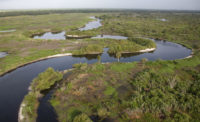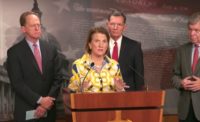The U.S. Environmental Protection Agency has announced the state-by-state allocation of $7.4 billion for water infrastructure from the Infrastructure Investment and Jobs Act. The action marks the first step toward putting the infrastructure package’s estimated total $1 trillion to $1.2 trillion in funds to use. But it will be weeks before EPA funds actually are released.
EPA on Dec. 2 disclosed how it will divide among states, tribes and territories the drinking-water and clean-water State Revolving Funds (SRFs) for fiscal 2022, the new law's first year. Over five years. the law's dollars through the SRFs will total almost $44 billion, according to the agency.
California will receive the largest state share of the 2022 SRF allocations, with $609.4 million.
Texas ranks second, with $507.7 million; New York is third, with $428.1 million; Illinois is fourth, with $288.3 million; and Florida is No. 5, with $275.4 million.
Funds Won't Be Released Right Away
Kristina Surfus, National Association of Clean Water Agencies managing director for government affairs, said via email that the EPA action “helps states know what IIJA allocations to anticipate.”
She adds, “But the actual release of funds will not be instantaneous.” Clean-water SRFs help fund wastewater-treatment facilities.
Surfus says EPA next will provide formal guidance to states for the SRF dollars and then each state must submit its “intended use plans” for EPA's approval before money is transferred to the state.
“We know EPA is working fast to prepare the guidance and other outreach materials for states and communities,” Surfus says. “Hopefully, funds will be available this spring.”
Tommy Holmes, the American Water Works Association’s legislative director, said via email the EPA announcement covers “the core SRF programs plus other programs in the IIJA that are being channeled through the SRF for administration.”
The core water SRF programs have been in place for more than 30 years and are familiar tools for state and local water agencies. Holmes says that the criteria and guidelines for funds from the established basic SRF funds already exist.
With the infrastructure-act funding, he adds, "States just have a lot more money to deal with now.” For drinking water SRFs, the allocations are based on the most recent EPA drinking-water needs survey.
The IIJA also creates new water programs, whose dollars are also expected to flow through the SRF program. The largest new program is $15 billion for replacing lead service lines over five years.
Two other new drinking water programs and one new clean water program, totaling $10 billion, are aimed at PFAS or other "emerging contaminants."
One drinking-water, emerging-contaminants program targets disadvantaged communities; the other has a broader scope, as does the clean-water program.
For the new programs, Holmes says, “We may not see guidance for the states until 2022.”
In a Dec.2 letter to governors, EPA Administrator Michael Reagan said, “The law’s investment in water is nothing short of transformational.”
Reagan noted the $50 billion the IIJA provides for SRFs and other EPA water programs is “the single largest investment in water that the federal government has ever made.”
State Matching Funds Trimmed or Eliminated
The infrastructure package also has some sweeteners for recipients of the EPA water funds. For example, for the core clean-water and drinking-water program funds, as well as for the new drinking water lead service line program, 49% of the funds will be in the form of outright grants or loans with principal forgiveness. The other 51% will be low-interest loans.
For 2022 and 2023, the state match is reduced to 10% for the core drinking-water and clean-water SRF funds, compared with 20% in 2021 and earlier years.
For the lead service line program the state match is eliminated.
Story corrected on 12/7/2021 to say that Illinois ranks fourth among states in allocations, with $288.3 million; and Florida is No. 5, with $275.4 million.






Post a comment to this article
Report Abusive Comment